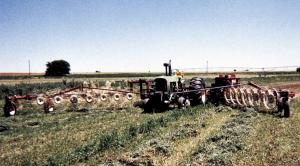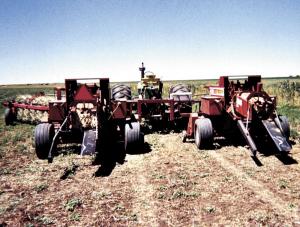2004 - Volume #28, Issue #4, Page #28
[ Sample Stories From This Issue | List of All Stories In This Issue | Print this story
| Read this issue]
Texas Toolbar Rakes And Bales 48 Ft.
 |
 |
"When you only get 20-50 bales per acre, you have to do a lot of driving if you're using a single baler on one windrow," points out Bailey.
To get away from all that driving, he built a 20-ft. wide double toolbar from 4 by 4-in. steel tubing. Two lengths of 4 by 4's welded to the toolbar extend forward to the axle of the 4020 where four 7/8-in. bolts hold them in place.
Two straps welded to the bottom of the toolbar serve as drawbar hitches for the twin Hesston 4590 balers. H&S wing rakes are mounted at either end of the toolbar to gather four windrows into two.
"You have to have the windrows in exactly the right location when you are pulling dual balers," explains Bailey. "Each rake has seven wheels, and they cover a span of about 40 ft. from one front wheel to another."
A pipe from the inside end of the wing rake rides inside a larger pipe attached to the toolbar end. The play provided by the different size pipes allows the rake to flex as it travels over the terraces and other irregular surfaces in the field. About half way up the wing rake, there is a pipe brace that connects to a weight box on the front end of the tractor. When the twin baler system is in transit, the wing rakes are folded in alongside the tractor and shorter pipe braces are used.
To power the balers, Bailey ran a 1,000-rpm pto shaft from the 4020 back to the double toolbar. Two pillow block bearings with a short shaft in between mount on each of the toolbars. A pulley transfers power to pulleys twice as big at either end of the toolbar. The double toolbar forms a protective channel for the belts. Bailey installed a framework above the toolbars at the same level as the tractor platform. It further encloses the belts, but also provides a walkway from the tractor to the toolbar and from one end of the toolbar to the other.
The size differential between the pulleys reduces the 1,000-rpm shaft to the 540 needed for the balers. Splines on shafts coming off the larger pulleys allow the pto shaft from the balers to be connected.
"One problem is getting shafts that are hard enough to last," says Bailey. "I can't get shafts made that are as hard as those on commercial balers. These last about a season, and then I have to cut them out and replace them."
Bailey's twin baler toolbar has always outlasted one set of balers. He has used it for about 10 years. At 40,000 to 50,000 bales each year, Bailey is confident the $2,000 or less he put into the toolbar has more than paid for itself.
Contact: FARM SHOW Followup, Charlie Bailey, 5621 CR 6220, Lubbock, Tex. 79415 (ph 806 744-3348).

Click here to download page story appeared in.

Click here to read entire issue
To read the rest of this story, download this issue below or click here to register with your account number.




